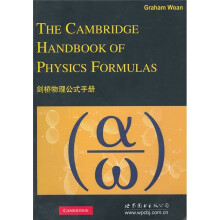Preface
How to use this book
1 Units constantsand conversions
1.1 Introduction
1.2 SI units
1.3 Physical constants
1.4 Converting between units
1.5 Dimensions
1.6 Miscellaneous
2 Mathematics
2.1 Notation
2.2 Vectors and matrices
2.3 Seriessummations,and progressions
2.4 Complex variables
2.5 Trigonometric and hyperbolic formulas
2.6 Mensuration
2.7 Differentiation
2.8 Integration
2.9 Special functions and polynomials
2.10 Roots of quadratic and cubic equations
2.11 Fourier series and transforms
2.12 Laplace transforms
2.13 Probability and statistics
2.14 Numerical methods
3 Dynamics and mechanics
3.1 Introduction
3.2 Frames of reference
3.3 Gravitation
3.4 Particle motion
3.5 Rigid body dynamics
3.6 Oscillating systems
3.7 Generalised dynamics
3.8 Elasticity80
3.9 Fluid dynamics
4 Quantum physics
4.1 Introduction
4.2 Quantum definitions
4.3 Wave mechanics
4.4 Hydrogenic atoms
4.5 Angular momentum
4.6 Perturbation theory
4.7 High energy and nuclear physics
5 Thermodynamics
5.1 Introduction
5.2 Classical thermodynamics
5.3 Gas laws
5.4 Kinetic theory
5.5 Statistical thermodynamics
5.6 Fluctuations and noise
5.7 Radiation processes
6 Solid state physics
6.1 Introduction
6.2 Periodic table
6.3 Crystalline structure
6.4 Lattice dynamics
6.5 Electrons in solids
7 Electromagnetism
7.1 Introduction
7.2 Static fields
7.3 Electromagnetic fields(general)
7.4 Fields associated with media
7.5 Forcetorque, and energy
7.6 LCR circuits
7.7 Transmission lines and waveguides
7.8 Waves in and out of media
7.9 Plasma physics
8 Optics
8.1 Introduction161 -8.2 Interference
8.3 Fraunhofer ditlraction,
8.4 Fresnel diffraction
8.5 Geometrical optics
8.6 Polarisation
8.7 Coherence (scalar theory)
8.8 Line radiation
9 Astrophysics
9.1 Introduction
9.2 Solar system data
9.3 Coordinate transformations (astronomical)
9.4 Observational astrophysics
9.5 Stellar evolution
9.6 Cosmology
Index

 缺书网
缺书网 扫码进群
扫码进群






